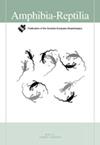越南北部濒危虎壁虎(Goniurosaurus lichtenfelderi)的首次生态评估:岛屿种群与大陆种群的微生境和宏观气候生态位比较
IF 1.3
4区 生物学
Q3 ZOOLOGY
引用次数: 1
摘要
利希滕费尔德虎壁虎,利希滕菲尔德Goniurosaurus目前只在越南北部和中国南部发现。由于其分布有限,该物种可能因人为影响而面临灭绝的威胁。最近,该物种被列入世界自然保护联盟濒危物种红色名录“易危”,并被列入《濒危野生动植物种国际贸易公约》附录二和越南政府法令第IIB组。然而,由于缺乏关于种群状况及其生态要求的详细信息,保护利希滕费尔德里野生种群的保护活动尚未实施。在本研究中,对利希滕费尔德里的微生境利用进行了评估。根据我们的实地调查,我们在植被覆盖率高的常绿森林地区发现了这种物种,并且非常靠近花岗岩地层上有岩石避难所的中小型溪流。冠层覆盖率、三个微观气候变量(空气、基质温度和湿度)、天气条件和基质类型是解释地衣小生境利用变化的最重要特征。结合宏观生态学(气候生态位)方法,通过比较岛屿和大陆两个地理位置遥远的种群,确定了利希滕费尔德里G.lichtenfelderi的复杂生态位。我们发现,利希滕费尔德里岛上和大陆种群在宏观气候和微观栖息地生态位上有很高的相似性。根据生态信息,我们建议采取保护行动,保护利希滕费尔德里的核心保护区,并减少未来人为影响对野生种群的负面影响。本文章由计算机程序翻译,如有差异,请以英文原文为准。
First ecological assessment of the endangered Lichtenfelder’s Tiger Gecko (Goniurosaurus lichtenfelderi) from northern Vietnam: Micro-habitat and macro-climatic niche comparisons between island and mainland populations
The Lichtenfelder’s Tiger Gecko, Goniurosaurus lichtenfelderi is currently known only from northern Vietnam and southern China. Because of its restricted distribution, the species is potentially threatened by extinction due to anthropogenic impacts. Recently, the species has been listed in the IUCN Red List of Threatened Species as “Vulnerable” and included in CITES Appendix II and the Vietnam Governmental Decree – Group IIB. However, conservation activities to safeguard wild populations of G. lichtenfelderi have not yet been implemented due to a lack of detailed information about the population status and its ecological requirements. In this study, the micro-habitat use of G. lichtenfelderi was assessed. As a result of our field surveys, we found this species in evergreen forest areas with a high percentage of vegetation coverage and in close proximity to medium or small stream sections with rocky shelters on granitic formations. Canopy coverage, three micro-climatic variables (air, substrate temperature and humidity), weather condition and substrate type were the most important characteristics explaining the variation in the micro-habitat use of G. lichtenfelderi. Coupled with a macro-ecological (climate niche) approach, the complex niches of G. lichtenfelderi were defined by comparing them between two geographically distant populations in island and mainland sites. We found high similarities in macro-climatic and micro-habitat niches between the island and mainland populations of G. lichtenfelderi. Based on the ecological information, we recommend conservation actions to protect the core refugia of G. lichtenfelderi and reduce negative influences of anthropogenic impacts on wild populations in the future.
求助全文
通过发布文献求助,成功后即可免费获取论文全文。
去求助
来源期刊

Amphibia-Reptilia
生物-动物学
CiteScore
3.10
自引率
6.20%
发文量
39
审稿时长
6-12 weeks
期刊介绍:
Amphibia-Reptilia is a leading European multi-disciplinary journal devoted to most of the aspects of herpetology: ecology, behaviour, evolution, conservation, physiology, morphology, paleontology, genetics, and systematics.
Amphibia-Reptilia publishes high quality original papers, short-notes, reviews, book reviews and news of the Societas Europaea Herpetologica (SEH). The Societas Europaea Herpteologica (SEH) website is located at: www.seh-herpetology.org.
 求助内容:
求助内容: 应助结果提醒方式:
应助结果提醒方式:


